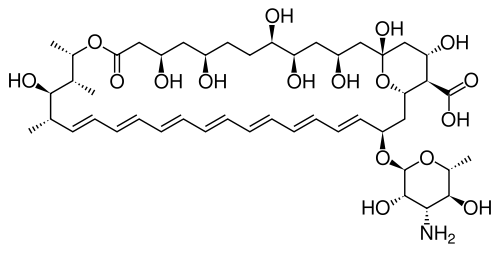Polyene

Polyenes are poly-unsaturated organic compounds that contain at least three alternating double and single carbon–carbon bonds. These carbon–carbon double bonds interact in a process known as conjugation resulting in some unusual optical properties. Related to polyenes are dienes, where there are only two alternating double and single bonds.
The following polyenes are used as antibiotics for humans: amphotericin B, nystatin, candicidin, pimaricin, methyl partricin, and trichomycin.[1]
Optical properties
Some polyenes are brightly colored, an otherwise rare property for a hydrocarbon. Normally alkenes absorb in the ultraviolet region of a spectrum, but the absorption energy state of polyenes with numerous conjugated double bonds can be lowered such that they enter the visible region of the spectrum, resulting in compounds which are coloured (because they contain a chromophore). Thus many natural dyes contain linear polyenes, e.g. beta-carotene, which is responsible for the color of carrots.
Chemical and electrical properties
Polyenes tend to be more reactive than simpler alkenes. For example, polyene-containing triglycerides are reactive towards atmospheric oxygen. Polyacetylene, which partially oxidized or reduced, exhibits high electrical conductivity. Most conductive polymers are polyenes, and many have conjugated structures.
Occurrence
A few fatty acids are polyenes. Another class of important polyenes are polyene antimycotics,[2]
- Representative Polyenes

 Leukotriene A4 is a regulator of the immune response.
Leukotriene A4 is a regulator of the immune response. Retinal is the chemical basis of animal vision..
Retinal is the chemical basis of animal vision.. Beta-carotene is red-orange pigment abundant in plants and fruits, notably carrots.
Beta-carotene is red-orange pigment abundant in plants and fruits, notably carrots. Polyacetylenes are a synthetic polymer of theoretical interest because they exhibit metallic properties upon oxidation.[4]
Polyacetylenes are a synthetic polymer of theoretical interest because they exhibit metallic properties upon oxidation.[4]
References
- ↑ Zotchev, Sergey B. (2003). "Polyene macrolide antibiotics and their applications in human therapy". Current Medicinal Chemistry. 10: 211–223. doi:10.2174/0929867033368448.
- ↑ NCBI Bookshelf (1996). "Polyene Antifungal Drugs". The University of Texas Medical Branch at Galveston. Retrieved 29 January 2010.
- ↑ Torrado, J. J.; Espada, R.; Ballesteros, M. P.; Torrado-Santiago, S. "Amphotericin B formulations and drug targeting" Journal of Pharmaceutical Sciences 2008, volume 97, pp. 2405-2425. doi:10.1002/jps.21179
- ↑ Lam, Jacky W. Y.; Tang, Ben Zhong "Functional Polyacetylenes" Accounts of Chemical Research 2005, volume 38, pp. 745-754. doi:10.1021/ar040012f
